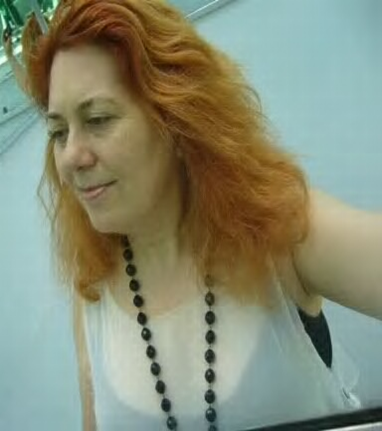Istanbul, Turkey
We stumbled upon Dilara’s art gallery whilst we were taking a lazy stroll in the winding streets of Cukucurma, the antique quartier of Istanbul. The exuberant children playing outside her gallery and the bold display of refine children’s artwork enticed us to take a step further inward into her gallery. Dilara’s sunny persona and enthusiasm left a strong impression on me. We did not get to talk much, although she did share with me about her art platform, the art program for children in the neighbourhoods, and the art scene in Istanbul. Here Dilara shares with us her views on art, its roles in the society, the need for artists to stay independent, and her platform in Istanbul
Interviewer
ViTRINE
V: Dilara, we know you have been extremely busy, please share with us your latest projects?
DA: I have been very busy. I have just completed my solo show in Istanbul and after which I also invited to participate in Canakkale Biennial where I am commissioned to create a public sculpture. I am also currently involved in Istanbul Children’s and Youth Art Biennial where I am conducting a special workshop. As the director of HAYAKA ARTI, I am also launching the platform’s latest communication portal, “interface-gallery.com”; the beta-version of this portal is already running. Last but not least, As the creative member of Istanbul Dance Theatre and I am now working on their latest project “BeHold” (a co production with a Dutch dance company: Bodies Anonymous)
V: The public sculpture that you will be producing for Canakkale Biennale, how will and does it correlate with your existing works?
DA: In my art, I question any cultural forms by means of abstract geometry or abstract forms. My work is to create simple universal root forms. My method is to analyze and question the codes that describe and also divide humanity. I personally believe that all human beings are created equal and thus in the same light I want my works to evoke similar (and collective) sensations to every person who views them and I hope the works will unfold new awareness and new perception of time and space and most importantly the meaning of being human.
V: Decades after decades, writers and visual artists often raised highly relevant social issues through their works…do you feel that it is an artist’s responsibility to address such issues?
DA: Let’s not call it responsibility but let’s think of it as an existential reason of being an artist. Be it at micro or macro level, through the engagement in art, artists question, analyze and reflect the reason of being alive. At a micro level, artists ponder over the (human) condition of an individual in a society and at macro level artists reflect on their existence and purpose in this universe.. I believe many artists’ works constantly explore such themes through their works and expression
V: and yet such issues, albeit highly perceptive and relevant, do not necessarily gain the support of the world’s ruling powers…Why? What is the support that an artist as a social-activist?
DA: Once the artists’ methods or the ideas are directly supported by the ruling powers, they become propaganda for the ruling power. Art and power are two opposite characteristics, thus artists must stay absolutely independent.
V: We learned about Hayaka Arti, hosting a series of children art program? Tell us more about the children’s art program?
DA: Siir Ozbilge is the leading artist of this project and other artists are invited to run neighbor-hood art projects with the children. Usually 10-12 children attend the workshops and each year, over 50 children participate in the projects. At the end of each year we exhibit the visiting artists and the children’s works side by side. This workshops may vary from painting, sculpture, photography, or art performance and we invite all artists from different countries. Recently Japanese butoh dancer Tetsuro ran a “Space Dance” workshop
V: What does your team hope to achieve through the program? Ideally and realistically?
We believe in the democratization of the individual’s expression and art is the best medium to democratize expressions. This is a independent project. Having said all these, there also times we questioned if we are, ironically, indirectly exerting control over human expressions because one of the key aim of the art workshops is to inculcate the value of non-aggression amongst children living in socially and economically under-developed neighbor-hoods in Istanbul. We wonder, with sorrow, if we are helping the system. Yet, at other times, we feel good when we see a minor positive change, in the participants, made possible by our efforts. Children are our future so we feel responsible regardless the irony.
V: Your vision of an ideal world…?
DA: As humans, we should evolve, to become more united, graceful and grateful. As humans have to be united with the rhythms of this universe…Nature runs in her own ways, too much control over nature destroys and distracts the evolution path.
V: Given a choice… would you choose to be a Maker of Myth or a Maker of Valued Art?
DA: A maker of Myth
About Dilara Akay
Born in 1963 in Adana, Turkey, Dilara Akay graduated from Bosphorous University in 1985 and lives and works in Istanbul. Dilara Akay is committed to exploring an interstitial space in the in-betweens of her curvilinear sculptures, which she calls “ARKS”. The rotational and calligraphical gestures of her work move through space with both spiritual and mathematical intuition, which leads the viewer into an experience of projective geometry. The bold dimensions of the sinuous lines of her work and the resulting strong shadows are the artistic expression of Akay’s underlying philosophical and spiritual inquiry, probe how the material and its effects spiral out of the immaterial, the void.
Please also visit http://www.dilaraakay.com/en/ and http://www.saatchionline.com/dilaraakay

